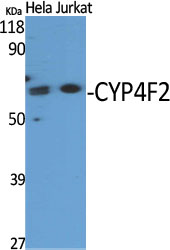CYP4F2 Polyclonal Antibody
- 产品详情
- 文献引用 : 1
- 实验流程
- 背景知识
Application
| WB, IHC-P |
|---|---|
| Primary Accession | P78329 |
| Reactivity | Human |
| Host | Rabbit |
| Clonality | Polyclonal |
| Calculated MW | 59853 Da |
| Gene ID | 8529 |
|---|---|
| Other Names | CYP4F2; Leukotriene-B(4) omega-hydroxylase 1; CYPIVF2; Cytochrome P450 4F2; Cytochrome P450-LTB-omega; Leukotriene-B(4) 20-monooxygenase 1 |
| Dilution | WB~~Western Blot: 1/500 - 1/2000. Immunohistochemistry: 1/100 - 1/300. ELISA: 1/40000. Not yet tested in other applications. IHC-P~~N/A |
| Format | Liquid in PBS containing 50% glycerol, 0.5% BSA and 0.09% (W/V) sodium azide. |
| Storage Conditions | -20℃ |
| Name | CYP4F2 {ECO:0000303|PubMed:10492403, ECO:0000312|HGNC:HGNC:2645} |
|---|---|
| Function | A cytochrome P450 monooxygenase involved in the metabolism of various endogenous substrates, including fatty acids, eicosanoids and vitamins (PubMed:10660572, PubMed:10833273, PubMed:11997390, PubMed:17341693, PubMed:18574070, PubMed:18577768). Mechanistically, uses molecular oxygen inserting one oxygen atom into a substrate, and reducing the second into a water molecule, with two electrons provided by NADPH via cytochrome P450 reductase (CPR; NADPH-ferrihemoprotein reductase). Catalyzes predominantly the oxidation of the terminal carbon (omega-oxidation) of long- and very long-chain fatty acids. Displays high omega-hydroxylase activity toward polyunsaturated fatty acids (PUFAs) (PubMed:18577768). Participates in the conversion of arachidonic acid to omega-hydroxyeicosatetraenoic acid (20-HETE), a signaling molecule acting both as vasoconstrictive and natriuretic with overall effect on arterial blood pressure (PubMed:10660572, PubMed:17341693, PubMed:18574070). Plays a role in the oxidative inactivation of eicosanoids, including both pro-inflammatory and anti- inflammatory mediators such as leukotriene B4 (LTB4), lipoxin A4 (LXA4), and several HETEs (PubMed:10660572, PubMed:10833273, PubMed:17341693, PubMed:18574070, PubMed:18577768, PubMed:8026587, PubMed:9799565). Catalyzes omega-hydroxylation of 3-hydroxy fatty acids (PubMed:18065749). Converts monoepoxides of linoleic acid leukotoxin and isoleukotoxin to omega-hydroxylated metabolites (PubMed:15145985). Contributes to the degradation of very long-chain fatty acids (VLCFAs) by catalyzing successive omega-oxidations and chain shortening (PubMed:16547005, PubMed:18182499). Plays an important role in vitamin metabolism by chain shortening. Catalyzes omega-hydroxylation of the phytyl chain of tocopherols (forms of vitamin E), with preference for gamma-tocopherols over alpha-tocopherols, thus promoting retention of alpha-tocopherols in tissues (PubMed:11997390). Omega-hydroxylates and inactivates phylloquinone (vitamin K1), and menaquinone-4 (MK-4, a form of vitamin K2), both acting as cofactors in blood coagulation (PubMed:19297519, PubMed:24138531). |
| Cellular Location | Microsome membrane; Peripheral membrane protein. Endoplasmic reticulum membrane; Peripheral membrane protein |
| Tissue Location | Liver. Also present in kidney: specifically expressed in the S2 and S3 segments of proximal tubules in cortex and outer medulla (PubMed:10660572). |
For Research Use Only. Not For Use In Diagnostic Procedures.

Provided below are standard protocols that you may find useful for product applications.
BACKGROUND
Omega-hydroxylase that oxidizes a variety of structurally unrelated compounds, including steroids, fatty acids and xenobiotics. Plays a key role in vitamin K catabolism by mediating omega-hydroxylation of vitamin K1 (phylloquinone), and menaquinone-4 (MK-4), a form of vitamin K2. Hydroxylation of phylloquinone and MK-4 probably regulates blood coagulation (PubMed:19297519, PubMed:24138531). Also shows arachidonic acid omega-hydroxylase activity in kidney, by mediating conversion of arachidonic acid to 20-hydroxyeicosatetraenoic acid (20-HETE), possibly influencing blood pressure control (PubMed:10660572, PubMed:17341693, PubMed:18574070). Also acts as a leukotriene-B(4) omega-hydroxylase by mediating conversion of leukotriene-B(4) (LTB4) to its omega-hydroxylated metabolite 20-hydroxyleukotriene- B(4) (20-OH LTB4) (PubMed:8026587, PubMed:9799565).
终于等到您。ABCEPTA(百远生物)抗体产品。
点击下方“我要评价 ”按钮提交您的反馈信息,您的反馈和评价是我们最宝贵的财富之一,
我们将在1-3个工作日内处理您的反馈信息。
如有疑问,联系:0512-88856768 tech-china@abcepta.com.






















 癌症的基本特征包括细胞增殖、血管生成、迁移、凋亡逃避机制和细胞永生等。找到癌症发生过程中这些通路的关键标记物和对应的抗体用于检测至关重要。
癌症的基本特征包括细胞增殖、血管生成、迁移、凋亡逃避机制和细胞永生等。找到癌症发生过程中这些通路的关键标记物和对应的抗体用于检测至关重要。 为您推荐一个泛素化位点预测神器——泛素化分析工具,可以为您的蛋白的泛素化位点作出预测和评分。
为您推荐一个泛素化位点预测神器——泛素化分析工具,可以为您的蛋白的泛素化位点作出预测和评分。 细胞自噬受体图形绘图工具为你的蛋白的细胞受体结合位点作出预测和评分,识别结合到自噬通路中的蛋白是非常重要的,便于让我们理解自噬在正常生理、病理过程中的作用,如发育、细胞分化、神经退化性疾病、压力条件下、感染和癌症。
细胞自噬受体图形绘图工具为你的蛋白的细胞受体结合位点作出预测和评分,识别结合到自噬通路中的蛋白是非常重要的,便于让我们理解自噬在正常生理、病理过程中的作用,如发育、细胞分化、神经退化性疾病、压力条件下、感染和癌症。

.jpg)





